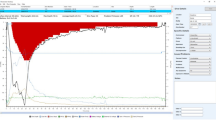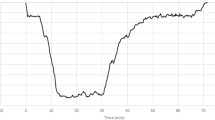Abstract
It is generally accepted that the incidence of decompression sickness (DCS) from hyperbaric exposures is low when few or no bubbles are present in the circulation. To date, no data are available on the influence of in-water oxygen breathing on bubble formation following a provocative dive in man. The purpose of this study was to compare the effect of post-dive hyperbaric versus normobaric oxygen breathing (NOB) on venous circulating bubbles. Nineteen divers carried out open-sea field air dives at 30 msw depth for 30 min followed by a 9 min stop at 3 msw. Each diver performed three dives: one control dive, and two dives followed by 30 min of hyperbaric oxygen breathing (HOB) or NOB; both HOB and NOB started 10 min after surfacing. For HOB, divers were recompressed in-water to 6 msw at rest, whereas NOB was performed in a dry room in supine position. Decompression bubbles were examined by a precordial pulsed Doppler. Bubble count was significantly lower for post-dive NOB than for control dives. HOB dramatically suppressed circulating bubble formation with a bubble count significantly lower than for NOB or controls. In-water recompression with oxygen to 6 msw is more effective in removing gas bubbles than NOB. This treatment could be used in situations of “interrupted” or “omitted” decompression, where a diver returns to the water in order to complete decompression prior to the onset of symptoms. Further investigations are needed before to recommend this protocol as an emergency treatment for DCS.


Similar content being viewed by others
References
Aharon-Peretz J, Adir Y, Gordon CR, Kol S, Gal N, Melamed Y (1993) Spinal cord decompression sickness in sport diving. Arch Neurol 50:753–756
Anderson D, Nagasawa G, Norfleet W, Olszowka A, Lundgren C (1991) O2 pressures between 0.12 and 2.5 atm abs, circulatory function, and N2 elimination. Undersea Biomed Res 18(4):279–292
Ball R (1993) Effect of severity, time to recompression with oxygen, and re-treatment on outcome in forty-nine cases of spinal cord decompression sickness. Undersea Hyperb Med 20(2):133–145
Balldin UI (1973) Effects of ambient temperature and body position on tissue nitrogen elimination in man. Aerosp Med 44:365–370
Balldin UI, Lundgren CEG (1972) Effects of immersion with the head above the water on tissue nitrogen elimination in man. Aerosp Med 43:1101–1108
Bert P (1878) La Pression barométrique. Recherches de physiologie expérimentale, Masson, Paris
Blatteau JE, Souraud JB, Gempp E, Boussuges A (2006a) Gas nuclei, their origin, and their role in bubble formation. Aviat Space Environ Med 77:1068–1076
Blatteau JE, Jean F, Pontier JM, Blanche E, Bompar JM, Meaudre E, Etienne JL (2006) Decompression sickness accident management in remote areas. Use of immediate in-water recompression therapy. Review and elaboration of a new protocol targeted for a mission at Clipperton atoll. Ann Fr Anesth Reanim 25(8):874–883. doi:10.1016/j.annfar.2006.04.007
Brubakk A (2004) Hyperbaric oxygen therapy: oxygen and bubbles. Undersea Hyperb Med 31(1):73–79
Edmonds C (1999) Australian underwater oxygen treatment of DCS. In: Key E and Spencer MP (eds) In-water recompression. Proceedings for the 48th workshop of the Undersea and Hyperbaric Medical Society, pp 2–15
Francis TJR, Mitchell SJ (2003) Pathophysiology of decompression sickness. In: Brubbak AO, Neuman TS (eds) The Bennett and Elliot’s physiology and medicine of diving, 5th edn. WB Saunders, London, pp 530–556
Moon RE, Gorman DF (2003) Treatment of the decompression disorders. In: Brubbak AO, Neuman TS (eds) The Bennett and Elliot’s physiology and medicine of diving, 5th edn. WB Saunders, London, pp 600–650
Nishi RY, Brubakk AO, Eftedal OS (2003) Bubble detection. In: Brubakk AO, Neuman TS (eds) Bennett and Elliot’s physiology and medicine of diving, 5th edn. WB Saunders, London, pp 501–529
Nossum V, Koteng S, Brubakk A (1999) Endothelial damage by bubbles in the pulmonary artery of the pig. Undersea Hyperb Med 26(1):1–8
Nossum V, Hjelde A, Brubakk A (2002) Small amounts of venous gas embolism cause delayed impairment of endothelial function and increase polymorphonuclear neutrophil inflammation. Eur J Appl Physiol 86:209–214. doi:10.1007/s00421-001-0531-y
Pyle RL (1999). Keeping up with the times: application of technical diving practices for in-water recompression. In: Key E, Spencer MP (eds) In-water recompression. Proceedings for the 48th workshop of the undersea and hyperbaric medical society, pp 74–88
Ross JAS, Trevett AJ, Forbes RF, Rae CK, Sheehan C (2004) The treatment of decompression illness arising from diving around the Orkeny islands October 1991–June 2003. Undersea Hyperb Med 31(3):354
Spencer MP (1976) Decompression limits for compressed air determined by ultrasonically detected blood bubbles. J Appl Physiol 40:229–235
Stipp W (2004) The influence of time to hyperbaric oxygen treatment on the outcome of neurological decompression illness in divers. Undersea Hyperb Med 31(3):353
Mollerlokken A, Nossum V, Hovin W, Gennser M, Brubakk A (2007) Recompression with oxygen to 160 kPa eliminates vascular bubbles, but does not prevent endothelium damage. Eur J Underwater Hyperbaric Med 8(1, 2):11–16
Conflict of interest statement
There is no financial or other relationship that might be perceived as leading to a conflict of interest (i.e., affecting author’s objectivity).
Author information
Authors and Affiliations
Corresponding author
Rights and permissions
About this article
Cite this article
Blatteau, JE., Pontier, JM. Effect of in-water recompression with oxygen to 6 msw versus normobaric oxygen breathing on bubble formation in divers. Eur J Appl Physiol 106, 691–695 (2009). https://doi.org/10.1007/s00421-009-1065-y
Accepted:
Published:
Issue Date:
DOI: https://doi.org/10.1007/s00421-009-1065-y




